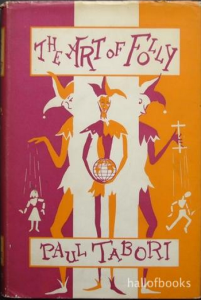
Author: Paul Tabori
Edition Cited in The Compleat Witch
Publisher: Chilton Company
City: New York (Philadelphia)
Year: 1961
Pages:
Binding: Hardback
Size:
Binding: Hardback
Size:
Front/Back Dust Jacket Flap Copy
THE ART OF FOLLY
By Paul Tabori
By Paul Tabori
“After his highly successful The Natural Science of Stupidity, Paul Tabori has written another provocative and scintillating book. Still on the trail of stupidity, he has largely chosen its more contemporary manifestations, treating them with the same erudition, the same humanistic approach, and the same puckish sense of humor that characterized his earlier book.
In The Art of Folly he is rewriting the history of mankind in terms of the three F’s – Fad, Fashion, and Folly.
Among the foolish FADS which he presents is the dueling manis of the so-called civilsed countries; the epidemics of suicide, quoting some bizarre cases of self-destruction; the tupil craze that ruined the Dutch economy; the lunacy of the South Sea Bubble and John Law’s half-baked financial schemes. He describes fads in medicine, like those of “natural magic” and “sympathetic cures.” He devotes a chapter to royal fads – including Frederick William I’s collection of “Long Fellows” – and provides a miniature survey of the principal crazes of the last fifty years.
His examination of folly through FASHIONS starts with a history of the “intimate and most intimate,” the taboos, shibboleths, and infinite variations of the garments closest to the skin. But he also examines fashions in beards, beauty-patches, bathing, garters, and stockings; presents portraits of some of the kings of fashion; holds up the mirror to the great ladies of the world who inspire and led the changing tastes of the last centuries. The fashion of improvisation, fashions in revolutions and in swear-words, in names and in dogs, in psychiatry and in literature – all are given a witty and searching treatment.
The final section is devoted to pure FOLLY – the folly of the wise, the idiocy of astrology and occultism, of Man’s constant attempt to forecast the future and his constant failure to do so. Two long chapters are devoted to political follies – especially those of the totalitarian countries. And the book ends with a “Martian Memo,” taking the space satellite view of our planet today.
This is a strikingly original work – full of laughter and tears, anger and pity. The many thousands who have read and loved The Natural Science of Stupidity will find new delight in The Art of Folly and many more will here discover Paul Tabori and his beguiling outlook on the human race.
In The Art of Folly he is rewriting the history of mankind in terms of the three F’s – Fad, Fashion, and Folly.
Among the foolish FADS which he presents is the dueling manis of the so-called civilsed countries; the epidemics of suicide, quoting some bizarre cases of self-destruction; the tupil craze that ruined the Dutch economy; the lunacy of the South Sea Bubble and John Law’s half-baked financial schemes. He describes fads in medicine, like those of “natural magic” and “sympathetic cures.” He devotes a chapter to royal fads – including Frederick William I’s collection of “Long Fellows” – and provides a miniature survey of the principal crazes of the last fifty years.
His examination of folly through FASHIONS starts with a history of the “intimate and most intimate,” the taboos, shibboleths, and infinite variations of the garments closest to the skin. But he also examines fashions in beards, beauty-patches, bathing, garters, and stockings; presents portraits of some of the kings of fashion; holds up the mirror to the great ladies of the world who inspire and led the changing tastes of the last centuries. The fashion of improvisation, fashions in revolutions and in swear-words, in names and in dogs, in psychiatry and in literature – all are given a witty and searching treatment.
The final section is devoted to pure FOLLY – the folly of the wise, the idiocy of astrology and occultism, of Man’s constant attempt to forecast the future and his constant failure to do so. Two long chapters are devoted to political follies – especially those of the totalitarian countries. And the book ends with a “Martian Memo,” taking the space satellite view of our planet today.
This is a strikingly original work – full of laughter and tears, anger and pity. The many thousands who have read and loved The Natural Science of Stupidity will find new delight in The Art of Folly and many more will here discover Paul Tabori and his beguiling outlook on the human race.
Table of Contents
Introduction . . . vii
I. FAD
The Lemmings . . . 3
Goethe and “Gloomy Sunday” . . . 13
Mammon’s Maniacs . . . 22
Quacks and Quests . . . 31
The Whims of Kings . . . 47
Fads Fever . . . 64
II. FASHION
Intimate and Most Intimate . . . 89
The Kings of Fashion . . . 119
The Queens of Fashion . . . 124
The Momentary Muse . . . 135
A Choice of Revolutions . . . 141
Semantic Fashions . . . 146
What’s in a Name? . . . 151
Cornucopia . . . 161
III. FOLLY
The Folly of the Wise . . . 169
The Veil of Isis . . . 185
The Emperor’s New Clothes . . . 195
Oxenstierna’s Law . . . 222
IV. L’ENVOI
The Martian Memo . . . 229
Bibliography . . . 235
Index . . . 239
Online Resources
Archive.org | GoodReads | Google Books | LibraryThing
OpenLibrary | Project Gutenberg | Wikipedia | WorldCat
Editions
(arranged by year)
Title: (if different)
Subtitle: (if different)
Subtitle: (if different)
Year: 1961
Publisher: Chilton Company; Philadelphia
Pages:
Binding:
Size:
Binding:
Size:
Cover Price:
ISBN:
LoC:
ISBN:
LoC:
Additional Photos/Images
(Sample Illustrations, Cited Edition)
(None)
(None)
Misc. Quotes
“Goethe’s Werther and Foscolo’s Jacopo Ortis made suicide fashionable for hapless lovers. Of course, such a fad wouldn’t survive in our enlightened and sturdily materialistic days.
Could it not?
More than a century after the romantic age, a young Hungarian journalist, poet, and musician fell in love with a “beautiful but dumb” dancer. Their affair was short but intense; then the girl decided to accept an engagement in Bulgaria where a new night club was recruiting dancers for a show. Though her lover pleaded, she didn’t want to miss the chance, and left.
The Hungarian poet was heartbroken. He was a creature of the night. Though he never drank alcohol, he haunted the cafes, the romantic inns, the dim dives of Budapest. Now he drank a couple of barack, the fiery apricot brandy, in a small, shabby night club where a middle-aged pianist was playing, singing old tunes in a hoarse whisper. Laszlo Javor, the forsaken lover, scribbled a few dozen lines. The pianist set them to music. And so the song Gloomy Sunday, with its lugubrious atmosphere of suicide and funerals, was born. At first no one wanted to touch it and Javor had to publish it at his own expense. Then it was recorded by a Viennese firm which needed a song to fill the reverse side of a disk. It because an overnight hit. It was translated into 26 languages and records by a dozen star singers, including Paul Robeson. It swept the world as the theme song of global depression, for the crash of 1929 in America had shaken or shattered the economies of most European countries. Gloomy Sunday suited the mood of that generation. It was the leitmotif of economic disaster – and of suicide, too. Learned studies were devoted to it as a symptom of the Decline of the West. Leading articles thundered against its defeatist spirit. Sermons were preached against its decadent creators and disseminators.
The little dancer disappeared somewhere in the Balkans and Javor was soon cured of his infatuation. He settled in Paris, became a clown in the Cirque Medrano, led a gypsy orchestra; then, during World War II, he joined the Maquis and was one of the most-decorated heroes of the Resistance, ending up as a wounded, tortured semi-invalid. Today he is a successful painter and a happily married man, but has still not quite lived down the reputation of that strange hit, Gloomy Sunday.”
Could it not?
More than a century after the romantic age, a young Hungarian journalist, poet, and musician fell in love with a “beautiful but dumb” dancer. Their affair was short but intense; then the girl decided to accept an engagement in Bulgaria where a new night club was recruiting dancers for a show. Though her lover pleaded, she didn’t want to miss the chance, and left.
The Hungarian poet was heartbroken. He was a creature of the night. Though he never drank alcohol, he haunted the cafes, the romantic inns, the dim dives of Budapest. Now he drank a couple of barack, the fiery apricot brandy, in a small, shabby night club where a middle-aged pianist was playing, singing old tunes in a hoarse whisper. Laszlo Javor, the forsaken lover, scribbled a few dozen lines. The pianist set them to music. And so the song Gloomy Sunday, with its lugubrious atmosphere of suicide and funerals, was born. At first no one wanted to touch it and Javor had to publish it at his own expense. Then it was recorded by a Viennese firm which needed a song to fill the reverse side of a disk. It because an overnight hit. It was translated into 26 languages and records by a dozen star singers, including Paul Robeson. It swept the world as the theme song of global depression, for the crash of 1929 in America had shaken or shattered the economies of most European countries. Gloomy Sunday suited the mood of that generation. It was the leitmotif of economic disaster – and of suicide, too. Learned studies were devoted to it as a symptom of the Decline of the West. Leading articles thundered against its defeatist spirit. Sermons were preached against its decadent creators and disseminators.
The little dancer disappeared somewhere in the Balkans and Javor was soon cured of his infatuation. He settled in Paris, became a clown in the Cirque Medrano, led a gypsy orchestra; then, during World War II, he joined the Maquis and was one of the most-decorated heroes of the Resistance, ending up as a wounded, tortured semi-invalid. Today he is a successful painter and a happily married man, but has still not quite lived down the reputation of that strange hit, Gloomy Sunday.”
Disclaimer
Due to the obscurity of some titles, the contents of The Compleat Witch Illustrated Bibliography Project may contain information that is inaccurate or incomplete. We encourage readers to submit corrections and pertinent addenda like images, quotes, or other information, either as a Comment on the appropriate post or via The Compleat Witch Illustrated Bibliography Facebook page.

